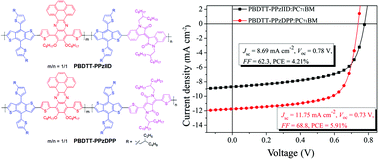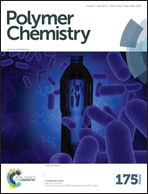Enhancing the photovoltaic properties of low bandgap terpolymers based on benzodithiophene and phenanthrophenazine by introducing different second acceptor units†
Abstract
Two novel donor–acceptor (D–A) type random conjugated terpolymers PBDTT-PPzIID and PBDTT-PPzDPP were synthesized by copolymerizing electron-rich alkylthienyl benzodithiophene (BDTT) and two different electron-deficient units, in which phenanthrophenazine (PPz) was the first acceptor unit, and isoindigo (IID) or diketopyrrolopyrrole (DPP) with a strong electron-withdrawing ability was the second acceptor unit, respectively. Compared to their parent polymer PTTPPz-BDTT, a broadening of the band in the long wavelength region from 500 to 850 nm and a significant decrease in HOMO levels were observed for the random terpolymers. Ca and PFN-Br were used as interfacial layers to optimize the devices, respectively. Pleasingly, after replacing Ca/Al with PFN-Br/Al as the cathode, the performance of both polymer devices improved greatly. A maximum power conversion efficiency (PCE) of 5.91% was obtained with a Voc of 0.73 V, a Jsc of 11.75 mA cm−2 and a FF of 68.8% in the PBDTT-PPzDPP/PC71BM-based device, while the PBDTT-PPzIID/PC71BM-based device achieved a PCE of 4.21%. To the best of our knowledge, this is one of the highest recorded FF values among PSCs based on previously reported phenazine copolymers.


 Please wait while we load your content...
Please wait while we load your content...